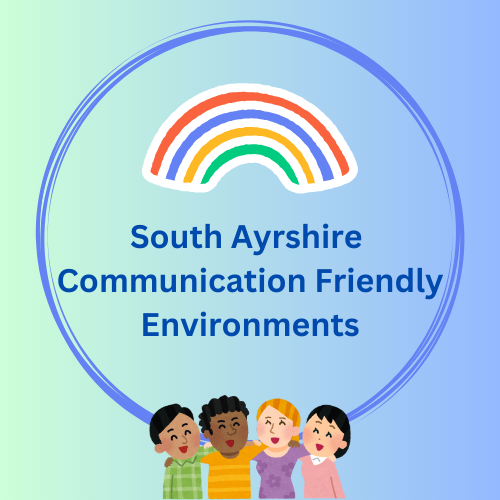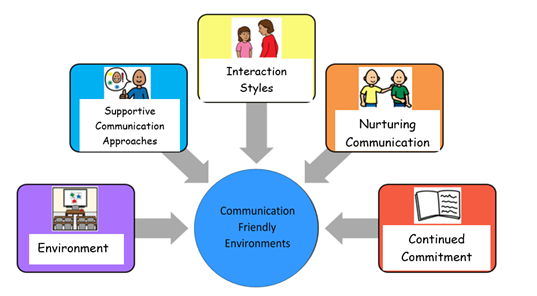
The South Ayrshire Communication Friendly Environments (SACFE) Communities Team are currently working collaboratively with community settings within the South Ayrshire Health and Social Care Partnership (HSCP) to successfully develop Communication Friendly Environments in the community. For example:
- Primary Care
- businesses
- leisure
- voluntary groups
- third sector
Community settings are supported by the SACFE Communities Team to work towards and achieve Communication Friendly Accreditation, which involves the five elements below:

What is the project’s goal?
The SACFE Communities Team work collaboratively with community settings within South Ayrshire HSCP to successfully support the communication skills of the entire South Ayrshire population and ensure that services are accessible for all through establishing effective Communication Friendly Environments, therefore enhancing life-long outcomes for all service users.
Establishing effective Communication Friendly Environments throughout our community settings will enable everyone to successfully support the communication skills and independence of the entire population to ensure that South Ayrshire services are accessible for all, resulting in improved attainment, inclusion, positive mental health and life-long outcomes.
Why get involved?
1.9 million children (1 in 5) are behind in speech and language skills (Speech and Language UK, 2023), with estimates predicting a 50% increase in the number of people with dementia over the next 20 years and the Parkinson’s population rising to around 15,000 (Scottish Government, 2023).
The increase in the number of children with speech, language and communication needs coupled with Scotland’s ageing population demonstrates the need to establish effective Communication Friendly Environments throughout our community settings to enable us to successfully support the communication skills and independence of the entire South Ayrshire population. Local businesses, community services and third sector partners have important roles in developing speech, language and communication skills through adjusting the environment to remove barriers and utilising supportive interaction styles to fulfil the communication potential of all, therefore enabling everyone to live healthier and more fulfilling lives.
What does the project entail?
Community settings work alongside and are fully supported by the SACFE Communities Team to achieve their full Communication Friendly Environment accreditation. The whole process is completely free and settings will nominate a ‘Communication Champion’ to lead and embed the Communication Friendly Journey in their establishment. The project involves:
- The SACFE Communities team arranging an initial meeting with an establishment to explain the Communication Friendly Environment journey.
- The SACFE Communities Team conducting an initial baseline walkaround of the establishment with the Communication Champion to gauge required visuals, for example door signs, cupboard/resource labelling etc. Any other supplementary visuals required by the setting will also be discussed, for example communication boards, visualised menus, social stories etc.
- Attendance at a two hour Total Communication Training session led by the SACFE Communication Team. This session covers speech, language and communication strategies, use of visuals and a Makaton taster.
- A badge accreditation visit by the SACFE Communities Team with presentation of the Communication Friendly plaque. Once accredited, the setting is then added to the Communication Friendly Map as part of ‘Mappy Monday’ on the SACFE Facebook page.
- Check in visits are then carried out in the future with accredited settings to gauge if any further training or resources are required.
Communication Friendly Environments in the community may have:
- Areas signposted and labelled using words and symbols – for example, toilets, entrances/exits, storage, specific resources etc. This supports everyone in successfully navigating the environment and accessing what they need, therefore developing independence.
- Staff consistently wearing name badges if applicable. This makes communication easier and more enjoyable for all.
- Use of symbols and pictures to aid understanding e.g. visual menus, communication boards, British Sign Language, Makaton etc. This ‘total communication approach’ ensures that understanding is supported and spoken language is reinforced through various methods.
- Acceptance of non-verbal communication as well as verbal communication with staff having an awareness of effective use of non-verbal communication, for example gestures/symbols.
- Staff using a range of language strategies to effectively support speech, language and communication skills through everyday interactions. For example, pausing for processing time, information given in manageable chunks and getting down to the individual’s physical level (especially children’s) when interacting with them.
Currently in South Ayrshire, there are over 40 community establishments on their Communication Friendly journey with over 20 settings accredited.
Communication boards are dotted around a variety of community settings throughout South Ayrshire.
Here is some feedback from our service users who have begun their communication friendly journey:
“I was able to use Makaton with a patient this week. I felt so confident introducing myself – I’m buzzing!”
– Staff Member
“Amy was amazing to us today. Our first visit for my son’s birthday and it’s definitely not the last. My son is non-verbal with SEN and the attention to detail from all the staff was amazing! Thank you for such kindness and a wonderful dining experience.”
– Parent (feedback from parent regarding impact of staff training at Tempura and the use of communication boards to support the child’s needs).
“Children are responding very well to the lanyard visuals. This is allowing them to communicate their needs more easily and parents have commented on the Communication Friendly notice board, saying it is helping with smooth transitions between home and playgroup”
– Staff Member (feedback from Domino Playgroup, Prestwick as a result of their staff training and use of visuals.)
“My son Jacob is 7 with Autism and ADHD. We attend multiple appointments in different settings and with various different medical professionals. He never coped well with these appointments previously. We attended A&E recently and we asked for the social stories book and a stop card, the difference in Jacob was amazing. He knew exactly what was going to happen and felt in control using his stop card. This meant for a smoother time at the hospital. It also meant that Jacob was well prepared and happier after. Jacob even said himself that it helped him”
– Parent (feedback from parent regarding impact of A&E staff training and the use of communication boards to support the child’s needs).
How can a community setting get involved?
Call 07483157590 or email: jordann.ford@aapct.scot.nhs.uk or claire.morrison3@aapct.scot.nhs.uk
We will arrange an informal discussion at a time that suits yourselves to explain more about what the Communication Friendly journey involves.

